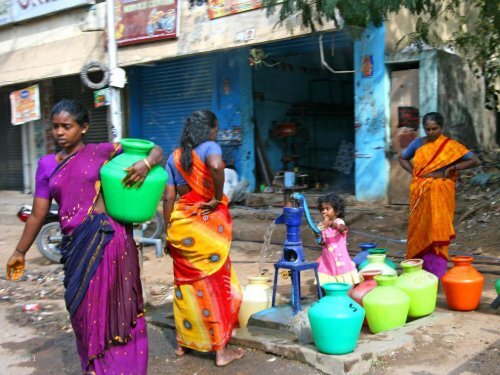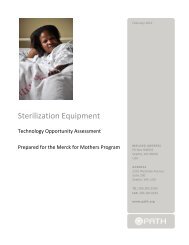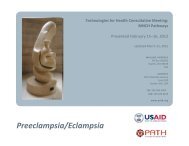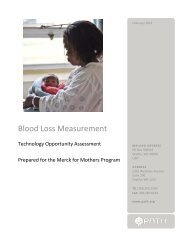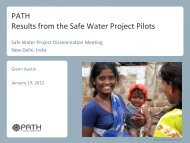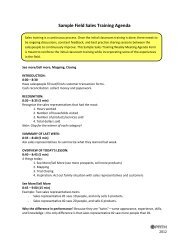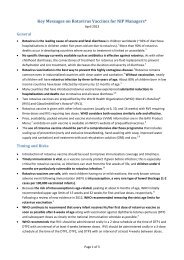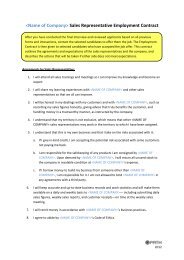Glenn Austin - PATH
Glenn Austin - PATH
Glenn Austin - PATH
Create successful ePaper yourself
Turn your PDF publications into a flip-book with our unique Google optimized e-Paper software.
Page 1
<strong>PATH</strong>Water, sanitation, and hygiene work and Safe Water ProjectoverviewSafe Water Project Dissemination MeetingNew Delhi, India<strong>Glenn</strong> <strong>Austin</strong>January 19, 2012Photo: <strong>PATH</strong>/<strong>Glenn</strong> <strong>Austin</strong>
Water, sanitation, and hygiene (WASH) needsGlobal and human health• 884 million to 2.6 billion people without access to safe water or sanitation,respectively. 1• Children under age 5 most impacted; over 4,000 die per day. 2India disease burden• Nearly a half million deaths per year. 3• Over 150,000 children under age 6 die. 3• 18% of all deaths of children ages 5 to 14. 4• Incalculable human and economic developmental costs.Not a traditional public health issue• Touches all lives every day.New approaches—beyond infrastructure, wells, and latrines• Community-led approaches.• Market based—new low-income consumer market.Sources:1. Access to safe drinking water improving; sanitation needs greater efforts [news release]. Geneva: World Health Organization; March 15, 20102. Boschi-Pinto C, Velebit L, Shibuya K. Estimating child mortality due to diarrhoea in developing countries. Bulletin of the World Health Organization. 2008;86(9):657-736.3. National Commission on Macroeconomics and Health. Background Papers: Burden of Disease in India. New Delhi, India: Ministry of Health & Family Welfare; 2005. Available at:http://www.who.int/macrohealth/action/NCMH_Burden%20of%20disease_(29%20Sep%202005).pdf4. Morris SK, Bassani DG, Awasthi S, Kumar R, Shet A, et al. Diarrhea, Pneumonia, and Infectious Disease Mortality in Children Aged 5 to 14 Years in India. PLoS ONE. 2011;6(5):e20119.Page 3
Overview of WASH-related work• Prevent young children from dying or failing to thrivedue to readily preventable diarrheal disease-relatedillnesses.• We focus on the intersection of vulnerable people,technology, and public-private partnerships tocatalyze appropriate solutions that are sustainableand scalable.• Initial focus areas: market-basked approaches anduser-centered product development.Page 4
Overview of <strong>PATH</strong>’s WASHdd* work*Water, air, sanitation, and hygiene to defeat diarrheal diseaseWater Treatment& TestingTest stripsAquatest and water testingSafe Water Project (SWP)Smart electrochlorinationSE200 & microfinanceHealth systems provisionZinc & ORSFermented-starch ORSORS/ORT cornersNational dd controlpoliciesIndoor AirQualityTRActionCookstovesSanitation & HygieneSanitation platformSanitation supply chainMarket assessmentsMenstrual management &sanitation systemsPage 5
Household solutionsfor familiesPage Photo credit: 6 <strong>PATH</strong>/Gabe Bienczycki
To what extent can market-based approaches helpaccelerate widespread adoption and sustained useof household water treatment and safe storage(HWTS) products by low-income populations overtime?Mkt photo herePage 7
The public-private spectrumWhere is the sweet spot for achieving impact, scale, and sustainability?<strong>PATH</strong>’s historical focusSWP market-based approachesPublicprovisionPrivateprovisionStrengthUser access based on needWeaknessesLess innovation,responsiveness, efficiencyStrengthsInnovation, responsiveness,efficiency, sustainabilityWeaknessesUser access based on demandand ability to payPage 8
Addressing the gaps in HWTS provisionMake it easier to designproducts that meet theneeds of low-incomeconsumersCatalyze partners toexplore creative newdistribution & saleschannelsResearch &developmentProductsProduction Marketing Distribution& salesCustomerserviceBetter understand how toinfluence purchase andsustained useHealthImpactAdapted from Michael Porter’s Value Chain Model and Value Chain Group’s Value Reference Model. In Competitive Advantage:Creating and Sustaining Superior Performance. New York, NY: The Free Press; 1985.Page 9
Mapping channel opportunity* by regionChannel India Vietnam Kenya CambodiaMicrofinanceInstitutions (MFIs)Self-Help Groups(SHG)~20M and growing,base-of-pyramid(BOP) focus35M, BOP focus,limited commercialabilityFragmented andsmallNALimited to incomegenerationloansStrong partnershipsbetween NGO andSHG31% population hasMFI, many NGOLimitedPromisingModerateLow priorityNongovernmentalOrganizations(NGOs)Fragmented, limitedcommercial abilityFragmented, limitedcommercial abilityAggregate targetconsumersStrong waterexpertiseRetailDirect SalesSome organized semirural,fragmentedruralStrategy for marketleadersWide reach butfragmentedRural sales ladiessuccessful pilotsWide reach butfragmentedBasket-of-goods(BOG) model useslocal vendorsWide reach butfragmentedGood pilot successPharmaciesWide reach butfragmentedWide reach and gooddistributionWide reach butfragmentedWide reach butfragmentedHealth ClinicsPublic-PrivatePartnership (PPP)Fragmented, ruralservice is lesseffective than urbanGood reach(government andprivate)Possible to distributedurable productsFragmented, publicclinics not optionPage 10* Note: Some pilots utilize multiple channels simultaneously.
What do we mean by “low income”?Commercial sector$5 per dayMarket-based solutionsweet spot?$1 to $5 per dayPublic sector$1 per dayPage 11
HWTS: Old/new consumer productPhoto credits: JMC Canney Science.com; ESP Water Products, Outback water purification system; and AquaovoPage 12
HWTS products: Proven health impact• 35% to 39% diarrheal diseasereduction.• Ensures safe storage.• Both durables and fast-movingconsumer goods (FMCGs).• Cost: US$7 to $100 per year.Page 13Photo: World Bank/Water and Sanitation Program
UptakeRates of scale in new product categoriesPotential adoption curve for new products5 to 10 yearsTime10 to 15 yearsSource: Golder PN, Tellis GJ. Will it ever fly? Modeling the takeoff of really new consumer durables. Marketing Science (1986–1998).1997;16(3):256–270.Page 14
Cell phone: A product category at global scalePage 15Photo credit: www.3giphoneinfo.com/mobile-phone-plan-comparison
Learning from the overnight success of the cell phonePhoto credits: Time Photographic History of Mobile Phones www.time.com/time/photogallery/0,29307,1636836_1389493,00.htmlPage 16
Page 171959
Page 181972
Page 191983
Page 202005Innovative products PLUS infrastructure, channels,maturity, competition, choice, and ubiquity.
Developing-country access achievedPage 21
Cell phone success required:• Infrastructure.• Regulated business andtechnical environment.• Distribution channels.• Economies of scale.• Platform technologies(e.g., GSM, displays, etc.)• Competition and choice.Page 22Photo credit: www.3giphoneinfo.com/mobile-phone-plan-comparison
Thank you to all our SWP partners!Quicksand DesignDMCDistrict PreventativeMedicine CenterACCESSPage 23


